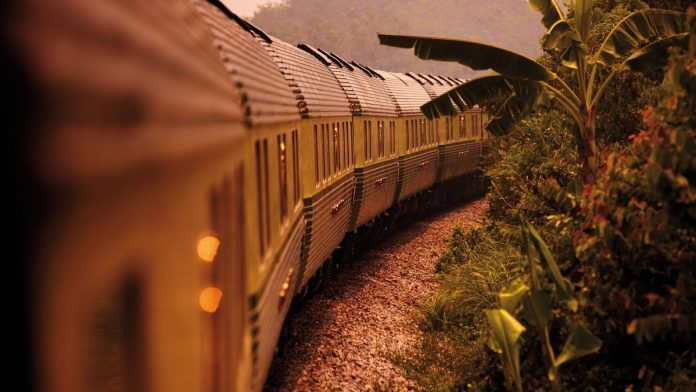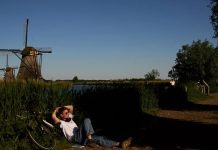By J.R. Patterson
A rainbow appeared briefly over Singapore, though I used to be the just one to note it, standing alone on the open caboose of our train because it travelled north over the Strait of Johor, leaving the Lion City behind.
It was only a transient sighting. An embankment of dark cloud was forming, and quickly overtook us as we passed into Malaysia, releasing one other torrent of rain and lightning that cut the muggy heat and raised a stench from the dirty strait.
Some ninety-four years ago, Henri Fauconnier, French author and rubber baron, described Malaysia as a spot where, though the “sky exults and sheds abundant tears, dark dismal days are unknown.”
And it was true today, as, despite the weather, I had watched passengers boarding the Eastern & Oriental Express, all of them smiling in eager anticipation of our journey into the depths of the Malayan peninsula.
The one sleeper train still operating in Malaysia
First, we were heading through the jungly central highlands to Taman Negara National Park, then along the west coast line to the colonial outposts of Butterworth and Georgetown, on the island of Penang. Finally, in 4 days and three nights, we’d retrace our path back to the swampy glamour of Singapore.
The Eastern & Oriental Express had once run all the way in which from Singapore to Bangkok before being scuppered in 2020. It was revived by Belmond in 2024 for multi-day round trips through Malaysia, and is now the one sleeper train still operating in Malaysia (the Intercontinental Express still runs overnight from the Thai-Malay border north to Bangkok).
And, as with anything Belmond, the worth – $4,650 (€4,110) – is high, strikingly higher than the national KTMB trains operating on the identical rails, nevertheless it procures a level of comfort and repair more luxurious than any Malaysian sultan in history ever had the great luck to experience.
The wood-panelled carriages are warm and welcoming, the en-suite compartments roomy and cushty. My State cabin had a chair and lounger that every converted to a single bed, and the en-suite a marble handbasin and a full-size shower with its own sweet and charming cabin steward.
As we shunted away, I used to be joined on the remark deck by various characters—Australian lawyers and financial investors, American artists, Malaysian construction magnates—enticed by the adjoining bar automobile (considered one of two on the train). They were all dressed to the nines, the Eastern & Oriental Express inspiring a certain etiquette amongst its passengers.
“An environment of relaxed refinement,” so the brochure assured me, “calls for smart-casual wear with a touch of understated elegance.”
Malaysia is a composite nation of Malay, Chinese, and Indian cultures, and the food, each ample and delicious, mixes those varied local cuisines with a touch of Provence. Our first lunch was kimchi niçoise with a crispy udon galette, and a coconut blancmanger with Nyonya chendol for dessert. Every day, entertainment was provided – a magician, a jazz trio, a karaoke night within the bar – and anyone could avail themselves of the onboard spa or mahjong set.
Most, nonetheless, selected to congregate on the remark deck, letting the wind blow away the warmth and carry the scent of sodden roots and woodsmoke.
Elephants, tigers, and bears in Taman Negara National Park
By morning, we had arrived at Merapoh, where great mounds of grey rock jut from the forest; the region is legendary for its caves. While some passengers went spelunking, some went on a photography scout, and others went for a riverine spa treatment, I joined a small group heading into Taman Negara National Park for some wildlife spotting.
At the back of a pickup truck, I sat beside local guide Nizam Khairun, a sweetly enthusiastic bird fanatic, who held up his phone and showed me pictures of hornbills, eagles, and a bit red and blue number called a Garnet Pitta.
“Birdwatchers come from everywhere in the world to see this,” he said, thrusting his phone in my direction. We were driving under a green cover, the fronds above us meeting like eyelashes over the road, the verge lined with palms like green fountains. Soon we got here across a covey of photographers waiting to catch a glimpse of an important argus.
“Hang on,” Nizam said, as he jumped from the truck, and went clucking into the undergrowth. A minute later, he reappeared, followed on his heels by an argus, a bird that resembles a Dickensian peacock, with its long, dun-colored tail.
“I call that one brother,” Nizam said because the photographers snapped away. “I’ve known him since he was hatched.”
The comb of Taman Negara is thick, and sightings are difficult. Throughout the tangle of trees and ferns, there are elephants and cattle-like gaur, tapirs and sun bears, and a few of the few remaining Malayan tigers. We weren’t so lucky as to see any of those, but there have been loads of faraway gibbon calls, elephant prints pressed into the red mud, and a tree that had been shredded by a sun bear attempting to get at a bee’s nest inside.
The colonial outpost of Georgetown has reinvented itself as a cultural capital
That afternoon, we shunted out of Merapoh and returned south, past vast palm oil and rubber tree plantations. Sometime within the night, we passed Kuala Lumpur (just as well, as its grand, central railway station is not any longer in use), and over breakfast, we watched the outskirts of Butterworth amass into the town itself.
A chartered ferry was waiting to hold us to the island of Penang, where we spent the morning exploring the colonial quarter of Georgetown. Chauffeur trishaws (three-wheeled peddle-bike taxis) had been chartered, and all got a map of the town and the liberty to do as they wished.
Georgetown has transformed itself from a colonial administrative centre to a cultural and artistic hub of Malaysia. I spent my time making a tour of the local street art, each mural and steel-rod sculpture detailing some scene of the island’s past: rickshaw coolies, bootblacks, imperial police, and sultans carried on litters.
Malaysia droops like a closed lily-bud off the bouquet of Asia, and within the evening, we slid like a drop of dew down its western coast, certain for Singapore. It felt too soon to be returning; this go through the country had passed in comfort and good grace, but too quickly. But nevertheless, all great trains arrive too soon.
The author was a guest of Belmond’s Eastern & Oriental Express.
Unlock the world’s wonders with unforgettable journeys tailored just for you! Whether you crave sun-kissed beaches, thrilling adventures, or rich cultural escapes, your dream destination awaits. Enjoy seamless travel with expert tips, exclusive deals, and handpicked experiences that Turn Every Trip into a lifetime memory.










